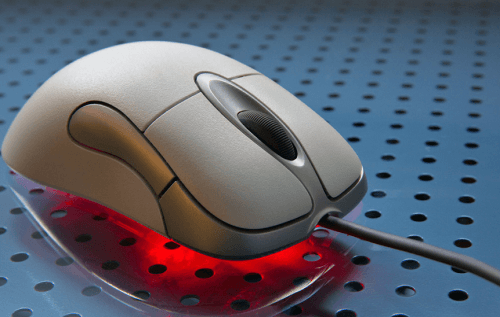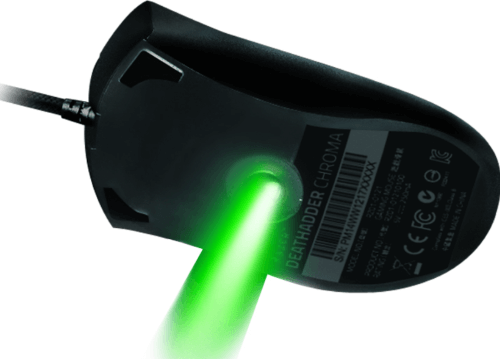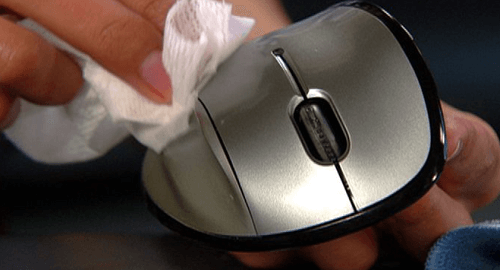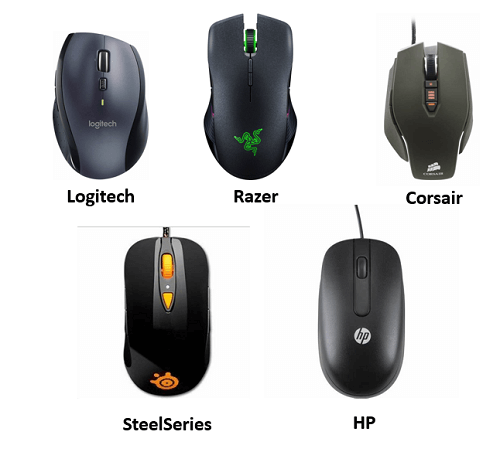What is a Laser Mouse?

A laser mouse is a type of computer mouse that uses a laser beam to detect movement and position on a surface. It is a modern alternative to the traditional ball mouse, which relies on physical contact with a surface to detect movement. Laser mice are now widely used in homes and offices because they offer a more precise and responsive experience than traditional mice.
The laser diode is the primary technology used in laser mice, which emits an infrared laser beam. This laser beam is directed onto the surface where the mouse is used, such as a mouse pad or a desk. The laser beam is reflected on the mouse as the mouse moves, which a sensor analyzes. This information is then processed by the mouse's internal circuitry, translating it into movement on the computer screen.
One of the key advantages of laser mice over traditional ball mice is their higher resolution. Laser mice can detect movement with much greater precision than ball mice, making them ideal for tasks that require fine control, such as graphic design or gaming. They are also more responsive than traditional mice, with lower latency and faster tracking speeds.
Laser mice are an essential tool for anyone who uses a computer for work or play. Their accuracy, responsiveness, and versatility make them ideal for various applications, from gaming to productivity. As technology advances, laser mice will likely continue to evolve and improve, offering users even greater performance and convenience.
History of Laser Mouse
The history of the laser mouse began in the early 2000s when traditional ball mice were the norm for computer users. Ball mice were inaccurate and required regular cleaning to maintain their performance. They also became sticky or unresponsive over time, especially when used on uneven surfaces.
In 2004, Logitech introduced the first laser mouse, the MX 1000. This mouse used a laser diode to detect movement and position on a surface rather than the traditional ball mechanism used in older mice. The laser diode emitted an infrared laser beam, which reflected the mouse by the surface it was used on. This allowed the mouse to detect even the smallest movements more accurately than traditional ball mice.
The Logitech MX 1000 was an immediate hit and soon rose to prominence as one of the most widely used mice available. It received compliments for its great precision, quick response time, and ergonomic design. Soon after, other manufacturers followed suit, and laser mice started to appear more often in homes and workplaces.
Over the years, laser mice have continued to evolve and improve. Manufacturers have added features like programmable buttons, wireless connectivity, and ergonomic designs to make them more user-friendly and versatile. Today, laser mice are available in various models and price points, making them accessible to everyone, from casual computer users to professional gamers and designers.
How a laser mouse works?
A laser mouse is a type of computer mouse that uses a laser beam to detect movement and position on a surface. The laser beam is emitted from a laser diode inside the mouse and is directed onto the mouse's surface, such as a mouse pad or desk. As the mouse moves, the laser beam is reflected in the mouse, where a sensor analyzes it. This information is then processed by the mouse's internal circuitry, translating it into movement on the computer screen.

Here are the steps involved in how a laser mouse works:
- The laser diode emits a beam of infrared light: The laser diode emits a laser beam when the mouse is moved, which is then focused on the surface you are using the mouse on.
- The laser beam reflects off the surface and back to the mouse: As the mouse moves, it is reflected the mouse by the surface it's being used on. The reflected beam contains information about the movement and position of the mouse.
- The sensor detects the reflected laser beam: Inside the mouse, there is a sensor designed to detect the reflected laser beam. The sensor detects the movement and position of the mouse based on the changes in the laser beam caused by the movement.
- The mouse's circuitry processes the information: The sensor sends the information about the movement and position of the mouse to the mouse's internal circuitry. This information is then processed and translated into movement on the computer screen.
- The cursor on the computer screen moves in response to the movement of the mouse: As you move the mouse, the cursor on the computer screen moves in response to the movement of the mouse. The faster you move the mouse, the faster the cursor moves on the screen.
- Additional features: Many laser mice have additional features, such as programmable buttons, adjustable DPI settings, and customizable RGB lighting. These features can be adjusted and customized to suit users' needs and preferences.
How to maintain and clean a laser mouse
Maintaining and cleaning your laser mouse is an important part of ensuring that it works properly and lasts for a long time. Here are some steps to follow to keep your laser mouse clean and well-maintained:

- Power off the mouse: Before cleaning your laser mouse, turn it off to avoid accidental clicks or movements.
- Remove any debris: Use a soft-bristled brush or a can of compressed air to remove any dust or debris that may have amassed on the mouse's surface or in the spaces between the buttons.
- Clean the surface: To clean the mouse's surface, use a microfiber cloth or a moist cloth. Abrasive or harsh chemicals should not be used as they may scratch the mouse's surface or harm the sensor.
- Clean the sensor: To clean the sensor at the bottom of the mouse, use a cotton swab or a soft-bristled brush. Dust or other debris that may have accumulated on the sensor should be removed gently. Avoid damaging or scratching the sensor.
- Check the mouse feet: The mouse feet located on the bottom of the mouse may also accumulate dust and debris. Use a soft-bristled brush or a cotton swab to remove debris from the mouse's feet.
- Replace the battery: If your laser mouse runs on a battery, replace it when it starts to run low. A low battery can cause your mouse to operate less efficiently and may even cause it to stop working altogether.
- Store the mouse properly: When not using your laser mouse, store it in a clean, dry place. Avoid exposing it to extreme temperatures or moisture, as this can cause damage to the mouse and affect its performance.
By following these steps, you can keep your laser mouse clean and well-maintained, ensuring it works properly and efficiently for a long time. It's a good idea to clean your mouse regularly, especially if you use it frequently or in a dusty or dirty environment. A clean mouse looks better and can improve its performance and accuracy, making it easier to use and more comfortable to work with.
Benefits of using a laser mouse
Using a laser mouse can offer many benefits over traditional ball mice, including improved accuracy, precision, and speed. Here are some of the key benefits of using a laser mouse:
- Higher accuracy: Laser mice use a laser beam to track movement, which allows for much greater accuracy than traditional ball mice. This means you can make smaller, more precise movements on the screen, which can be especially useful for tasks like graphic design, photo editing, or gaming.
- Better tracking on different surfaces: Laser mice are designed to work on various surfaces, including glossy or textured surfaces that may cause traditional ball mice to skip or stick. This means you can use your laser mouse on a wider range of surfaces, making it more versatile and convenient.
- Faster response time: Laser mice typically have a faster response time than traditional ball mice so that they can track movements more quickly and accurately. This can be especially important for tasks that require quick reflexes or precise movements, such as gaming or video editing.
- Customizable settings: Many laser mice have settings that allow you to adjust features like sensitivity, button assignments, and lighting. This means you can tailor your mouse to your specific needs and preferences, making it more comfortable and efficient.
- Ergonomic design: Laser mice are often designed with ergonomic features that make them more comfortable for extended periods. This can include features like contoured shapes, rubberized grips, and adjustable weights, which can reduce hand fatigue and improve overall comfort.
- Durability: Laser mice are typically more durable than traditional ball mice, as they don't have any moving parts that can wear out or break. This means that they can last longer and require less maintenance over time.
Popular brands and models of laser mice
Many popular brands and models of laser mice are on the market today, each with unique features and specifications. Here are some of the most popular brands and models of laser mice:

- Logitech: Logitech is a well-known computer peripherals brand offering a wide range of laser mice. Some of the most popular models include the Logitech MX Master 3, which features customizable buttons, a high-precision sensor, and a comfortable ergonomic design, and the Logitech G Pro X Superlight, designed specifically for gaming and features a lightweight design and customizable lighting.
- Razer: Razer is another popular brand in the gaming industry and offers a variety of laser mice designed for gamers. Some popular models include the Razer DeathAdder Elite, which features customizable buttons, an advanced sensor, and customizable lighting. The Razer Basilisk V2 offers adjustable scroll wheel resistance and a customizable thumb button.
- Corsair: Corsair is a well-known brand in the gaming industry and offers a variety of high-performance laser mice. Some of the most popular models include the Corsair Dark Core RGB/SE, which features customizable buttons, a high-precision sensor, and wireless charging, and the Corsair Harpoon RGB Wireless, which offers a lightweight design and customizable lighting.
- SteelSeries: SteelSeries is a popular brand in the gaming industry and offers a variety of laser mice designed for gamers. Some of the most popular models include the SteelSeries Rival 600, which features customizable weight and balance, a high-precision sensor, and customizable lighting, and the SteelSeries Sensei Ten, which offers a comfortable, ambidextrous design and customizable buttons.
- HP: HP is a well-known computer industry brand that offers various laser mice for home and office use. Some of the most popular models include the HP Spectre Rechargeable Mouse 700, which features a sleek, modern design and customizable buttons, and the HP Z3700 Wireless Mouse, which offers a compact, portable design and customizable colours.
These are just a few of the many popular brands and models of laser mice today. When choosing a laser mouse, it's important to consider your specific needs and preferences, such as whether you need a mouse for gaming or office work and what features are most important to you, such as customizable buttons, ergonomic design, or customizable lighting.
Common issues with laser mice and how to troubleshoot
Laser mice are generally reliable and require minimal maintenance, but like any electronic device, they can experience issues from time to time. Here are some common issues with laser mice and how to troubleshoot them:
- Connectivity issues: If your laser mouse isn't connecting to your computer, the first step is to check the batteries or charging cable to ensure that they're properly connected and charged. If that doesn't work, try restarting your computer or resetting the mouse using the reset button on the bottom of the device. You may also need to update your mouse drivers or check your computer's Bluetooth settings to ensure the mouse is properly paired.
- Cursor movement issues: If your mouse cursor is moving erratically or not at all, the first step is to check the surface on which you're using the mouse. Laser mice can be sensitive to certain surfaces, so try using a different mouse pad or surface. Adjust the mouse sensitivity settings in your computer's control panel, or try cleaning the sensor on the bottom of the mouse with a soft cloth.
- Button issues: If your mouse buttons aren't working properly, try cleaning the buttons with a soft cloth or compressed air. If the buttons are physically damaged, you may need to replace the mouse or take it to a repair shop. You may also need to adjust the button settings in your computer's control panel or update the mouse drivers.
- Scroll wheel issues: If your mouse scroll wheel isn't working properly, try cleaning it with a soft cloth or compressed air. You may also need to adjust the scroll wheel settings in your computer's control panel or update the mouse drivers. If the scroll wheel is physically damaged, you may need to replace the mouse or take it to a repair shop.
- Lag or delay issues: If your mouse is experiencing lag or delay, try moving the USB receiver closer to the mouse or using a different USB port. You may also need to update the mouse drivers or adjust the mouse settings in your computer's control panel. If none of these solutions work, you may need to replace the mouse or take it to a repair shop.
If you're experiencing persistent issues with your mouse, it's always a good idea to consult the user manual or contact the manufacturer for assistance. Proper maintenance and troubleshooting allow you to keep your laser mouse in good working order for years.
|




 For Videos Join Our Youtube Channel: Join Now
For Videos Join Our Youtube Channel: Join Now










